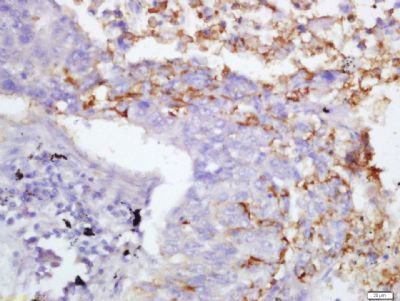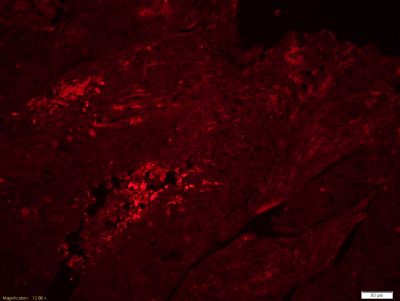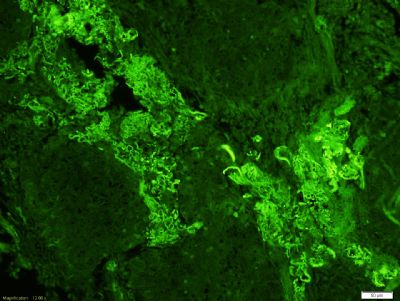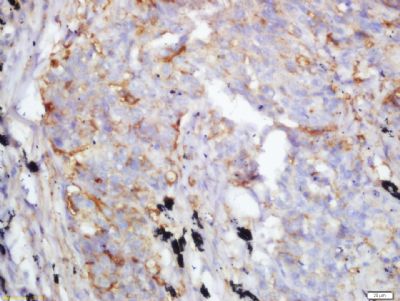Fibrinogen beta chain,纤维蛋白原β链抗体
产品名称: Fibrinogen beta chain,纤维蛋白原β链抗体
英文名称: Anti-Fibrinogen beta chain antibody
产品编号: HZ-10124R
产品价格: null
产品产地: 中国/美国
品牌商标: HZbscience
更新时间: 2023-08-17T10:24:20
使用范围: WB,ELISA,IHC-P,IHC-F,IF
- 联系人 : 鲍丽雯
- 地址 : 上海市闵行区闵北路88弄1-30号第22幢AQ136室
- 邮编 : 200612
- 所在区域 : 上海
- 电话 : 139****0749
- 传真 : 021-60345367
- 邮箱 : www.shzbio.net
Fibrinogen beta chain,纤维蛋白原β链抗体
产品编号HZ-10124R
英文名称Fibrinogen beta chain
中文名称纤维蛋白原β链抗体
别 名FGB; FIBB_HUMAN; Fibrinogen B beta polypeptide; Fibrinogen beta chain; Fibrinogen beta polypeptide chain; Liver regeneration-related protein LRRG036/LRRG043/LRRG189; HEL-S-78p; MGC104327; MGC120405; OTTHUMP00000197066.
说 明 书0.1ml 0.2ml
研究领域心血管 细胞生物
抗体来源Rabbit
克隆类型Polyclonal
交叉反应 Human, Mouse, Rat, Chicken, Dog, Pig, Cow, Horse, Rabbit, Guinea Pig,
Fibrinogen beta chain,纤维蛋白原β链抗体产品应用WB=1:100-500 ELISA=1:500-1000 IHC-P=1:100-500 IHC-F=1:100-500 ICC=1:100-500 IF=1:100-500 (石蜡切片需做抗原修复)
not yet tested in other applications.
optimal dilutions/concentrations should be determined by the end user.
分 子 量51kDa
细胞定位分泌型蛋白
性 状Lyophilized or Liquid
浓 度1mg/1ml
免 疫 原KLH conjugated synthetic peptide derived from human Fibrinogen beta chain
亚 型IgG
纯化方法affinity purified by Protein A
储 存 液0.01M TBS(pH7.4) with 1% BSA, 0.03% Proclin300 and 50% Glycerol.
保存条件Store at -20 °C for one year. Avoid repeated freeze/thaw cycles. The lyophilized antibody is stable at room temperature for at least one month and for greater than a year when kept at -20°C. When reconstituted in sterile pH 7.4 0.01M PBS or diluent of antibody the antibody is stable for at least two weeks at 2-4 °C.
Fibrinogen beta chain,纤维蛋白原β链抗体PubMedPubMed
产品介绍background:
The protein encoded by this gene is the beta component of fibrinogen, a blood-borne glycoprotein comprised of three pairs of nonidentical polypeptide chains. Following vascular injury, fibrinogen is cleaved by thrombin to form fibrin which is the most abundant component of blood clots. In addition, various cleavage products of fibrinogen and fibrin regulate cell adhesion and spreading, display vasoconstrictor and chemotactic activities, and are mitogens for several cell types. Mutations in this gene lead to several disorders, including afibrinogenemia, dysfibrinogenemia, hypodysfibrinogenemia and thrombotic tendency. Alternatively spliced transcript variants encoding different isoforms have been found for this gene. [provided by RefSeq, Jun 2014].
Function:
Fibrinogen has a double function: yielding monomers that polymerize into fibrin and acting as a cofactor in platelet aggregation.
Subunit:
The protein encoded by this gene is the beta component of fibrinogen, a blood-borne glycoprotein comprised of three pairs of nonidentical polypeptide chains. Following vascular injury, fibrinogen is cleaved by thrombin to form fibrin which is the most abundant component of blood clots. In addition, various cleavage products of fibrinogen and fibrin regulate cell adhesion and spreading, display vasoconstrictor and chemotactic activities, and are mitogens for several cell types. Mutations in this gene lead to several disorders, including afibrinogenemia, dysfibrinogenemia, hypodysfibrinogenemia and thrombotic tendency. [provided by RefSeq, Jul 2008].
Subcellular Location:
Secreted.
DISEASE:
Defects in FGB are a cause of congenital afibrinogenemia (CAFBN) [MIM:202400]. This rare autosomal recessive disorder is characterized by bleeding that varies from mild to severe and by complete absence or extremely low levels of plasma and platelet fibrinogen. Note=Patients with congenital fibrinogen abnormalities can manifest different clinical pictures. Some cases are clinically silent, some show a tendency toward bleeding and some show a predisposition for thrombosis with or without bleeding.
Fibrinogen beta chain,纤维蛋白原β链抗体Similarity:
Contains 1 fibrinogen C-terminal domain.
Gene ID:
2244
Database links:
Entrez Gene: 2244 Human
SwissProt: P02675 Human
Unigene: 300774 Human
Important Note:
This product as supplied is intended for research use only, not for use in human, therapeutic or diagnostic applications.




